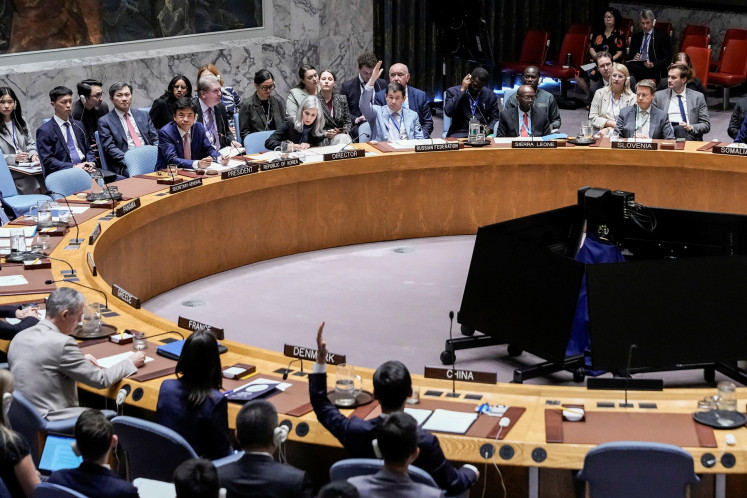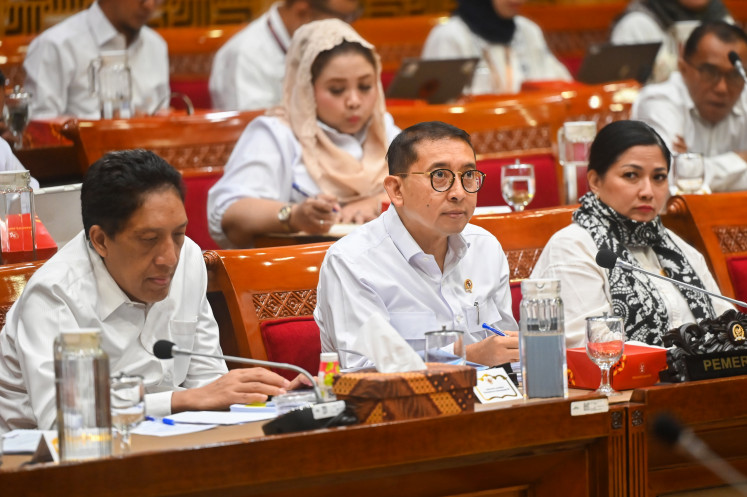Popular Reads
Top Results
Can't find what you're looking for?
View all search resultsPopular Reads
Top Results
Can't find what you're looking for?
View all search resultsGood fences make good neighbors
The situation between Indonesia and Malaysia is apparently cooling down
Change text size
Gift Premium Articles
to Anyone
T
he situation between Indonesia and Malaysia is apparently cooling down. It is interesting to observe how the two neighboring states are often trapped in the same scenario: Upholding national positions in
border areas subject to claims by both sides.
Tension surrounding border areas is by no means unique to Indonesia and Malaysia only. Borders represent points of potential friction or cooperation, so it is not strange for problems to occur when states are so close to one another with shared interests and claims.
Coastal states such as Indonesia and Malaysia, according the United Nations Convention on the Law of the Sea, are entitled to maritime areas around their land territories. Those maritime zones/areas are the territorial sea (reaching 12 nautical miles from the coast), exclusive economic zones or ZEE (200 nm) and continental shelf (potentially up to 350 nm or more).
Looking at the world map, it is easy to tell it is impossible for any country to claim a full 200 nautical miles without its claims overlapping with those of other countries.
To resolve the overlapping claims issue, countries need to draw boundary lines. This is known as a delimitation process, and it takes into account geospatial, legal and political considerations (among other things). If boundary lines are unachievable, states can establish an alternative arrangement such as a maritime joint development zone.
Such a situation is what Indonesia and Malaysia are currently facing in the waters off Tanjung Berakit in Riau. Both are entitled to maritime claims, but their claims overlap since the distance between the two is less than 24 nautical miles. Indonesia and Malaysia have yet to agree on maritime boundaries. In the absence of a maritime boundary, no border violation has occurred.
However, the critical issue here is that both Indonesia and Malaysia have their own/unilateral claims over maritime spaces in this area. It seems that Indonesia uses its 2009 fisheries management map, while Malaysia bases its claim on a map published in 1979.
Thus, every time fishermen from Malaysia come into the area, Indonesia will consider them as a border infringement and vice versa.
While some have opined that more accurate coordinates on the offense are required, we should keep in mind that such coordinates would help define whether the location is within Indonesia or Malaysia, based on, once again, the unilateral claims of each country.
As long as an offense is carried out in an overlapping area, the coordinates will not do much to clarify or resolve matters.
However, each state may not officially recognize such terms as “overlapping claims” since they are likely to simply say “our territorial sea” in referring to an area of sea claimed to be part of more than one state. Therefore, in this case coordinates are essential for each side to support their unilateral claims.
As President Yudhoyono mentioned in his speech on Sept. 1, 2010, Indonesia and Malaysia should accelerate the delimitation of their maritime boundaries. Pursuant to the UN convention, in cases of overlapping territorial sea between the two countries, Article 15 states that neither of the two countries
“is entitled, failing agreement between them to the contrary, to extend its territorial sea beyond the median line”.
This indicates that the countries should draw their maritime border using a median line between them. However, boundaries are all about agreement.
A median line between two countries cannot be assumed to be a final and binding border until the two countries agree to do so. In the end, it is up to them to negotiate and consider any relevant factors in establishing final and binding maritime boundaries.
One might ask why Indonesia and Malaysia are apparently taking such a long time to settle their maritime boundaries. In fact, the first maritime boundary agreement Indonesia signed was the one with Malaysia in 1969.
However, the completion of maritime boundary delimitation does not seem to have run very smoothly between the two countries. One of the issues is the sovereignty dispute between Malaysia and Singapore over three islands/rocks in the eastern entrance to the Singapore Strait, i.e. Pedra Branca, Middle Rocks and South Ledge. After a 30-year dispute over the islands, the conflicting claims were settled in 2008 by the International Court of Justice.
Pedra Branca was awarded to Singapore, and Malaysia got Middle Rocks. Meanwhile, the ownership of South Ledge is still pending. Only once certainty of sovereignty over islands/rocks is established, can maritime delimitation begin.
Even though Indonesia is not a party to the dispute, it is still affected since the dispute prevents countries in the area from drawing maritime borders.
The recent tension built between Indonesia and Malaysia reminds us once again how important it is to settle maritime boundaries. Borders are important, as Robert Frost states in his poem “Mending Wall” that ‘good fences make good neighbors’. However, it is worth noting that this good fence has to be built by both sides and that all parties in question need to have a willingness to achieve a lasting solution.
Beyond boundary issues, Indonesia and Malaysia need to work collaboratively in resolving problems raised in border areas. A cautious, mature, calm and gradual approach is required by both sides without resorting to unhelpful provocation.
The writer is a lecturer at the Department of School Geodetic Engineering, University of Gadjah Mada, Yogyakarta.










